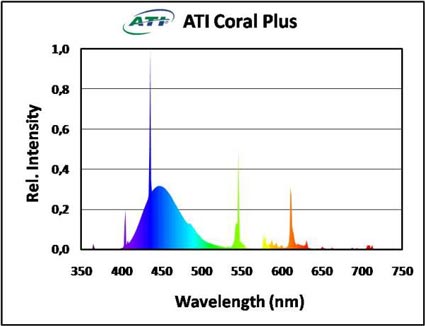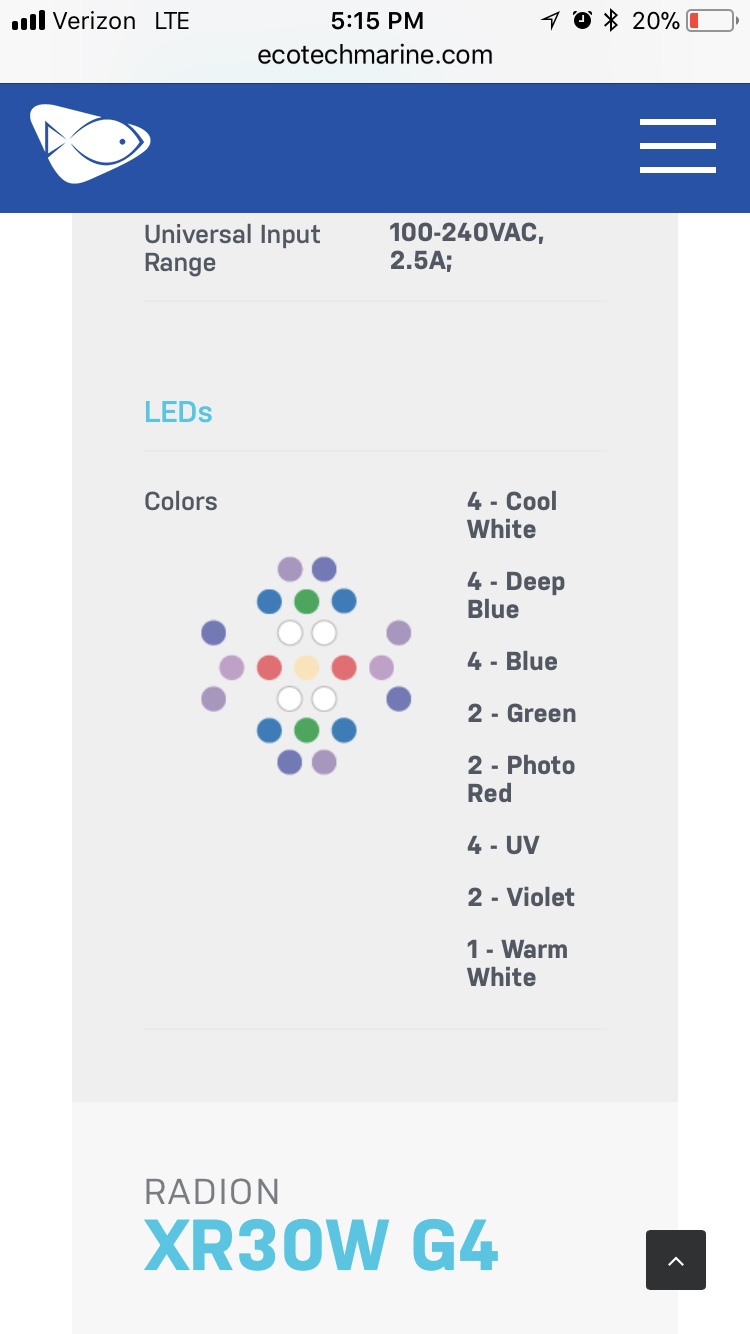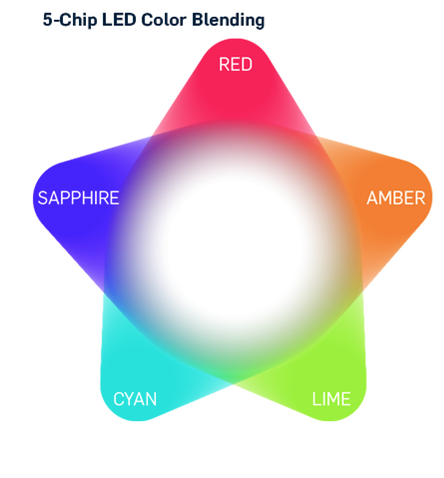Where’d you pull the kessil spectrum from? That’s cool.No...................not exactly..and certainly not in HIGH vs LOW..

Random picked spectrum

I actually expaected to see more in the 500 525.
Follow along with the video below to see how to install our site as a web app on your home screen.
Note: This feature may not be available in some browsers.
Where’d you pull the kessil spectrum from? That’s cool.No...................not exactly..and certainly not in HIGH vs LOW..

Random picked spectrum

Where’d you pull the kessil spectrum from? That’s cool.
I actually expaected to see more in the 500 525.
Kelvin spread ?
Actually I belive they cluster the led ins kessil and Radion is becuse it’s cheap to make.
Search back a few years and research something called the dream chip. Basically a kessil.
But that has little to do with par and spectrum.
Also folks forget , there’s a ton of metal halides that are just awful. Really expensive , terrible reflectors and made a huge hot spot. I actually have one in the basement. It’s horrble.


I believe that BRS posts the spectral graphs in their brstv investigates for both the 360 and the AP700Where’d you pull the kessil spectrum from? That’s cool.
I actually expaected to see more in the 500 525.
This isn’t the same as a t5 bulb
Each one is it’s own spotlight. It’s not as efficient as a t5 bulb. Not sure if I am explaining it right

I actually expected to see more in the 500 525.
eh , they all grow coral.
Let’s not make it one of those debates.
This is what I was I trying to get to the bottom of...My friend used 400 watt mh in his 8 inch deep sps tank. They only run for 6 hours a day but yes par is like 800 and his sps are beautiful. If I ran 800 with my led I bleach them all. I am not an engineer like your friend but common send tells you there s something different
One of the guys that I went to Engineering School with now works Phillips in Europe. Although totally possible right now, if diodes were made the same way as MH or T5s with wide bands of phosphors and wide spectrum, then there is no energy savings and the diodes would have smallish shelf lives of around 5-8K hours. The real efficiences and draw are to cut spectrum and save power - 8 watts to light a hallway when all that is needed is a narrow band of visible light. He works on power supplies and their main clients are for general lighting... .
“It is only a matter of time before white LEDs using blue LED chips will disappear from the market,” said Shuji Nakamura at a forum on GaN technology in July organized by Nikkei Asian Review. The comment from the inventor of the blue LED chip and Nobel Laureate shocked the industry. Nakamura shares a Nobel Prize in Physics with two Japanese inventors Isamu Akasaki and Hiroshi Amano for their invention of the blue LED. Yet, Nakamura’s recent remark completely derails his previous accomplishments. Industry insiders in China try to decode Nakamura’s comments to determine whether it reflects embedded flaws in blue LEDs design, or whether his motive is to promote Soraa’s purple LEDs.
The advantages of purple LEDs
It will be difficult to determine the motive of Nakamura’s comment, but an objective comparison can be drawn between purple and blue LEDs.
Purple LED potential and outlook was affirmed by Wu Hong. “White light efficiency is higher when converted from purple LEDs, lighting distribution is more uniform, and has better CRI,” he said. “These can cut energy, reduce carbon emission, and improve lighting quality. All these carry significant meaning. Even though it has not become widespread on the market because of its high pricing, its advantages are quite obvious.”
What specific advantages does white LEDs made from purple LEDs have?
- High CRI. When white light is created from exciting phosphor coated on purple LEDs, the peak wavelength of the blue light is not as intense. Moreover, the output encompasses all visible light wavelengths. Hence, CRI is much higher, and closer to ideal white light found in sunlight. It has a high red CRI R9, and can reach Ra 95.
- High luminous efficacy:
- Purple LEDs are manufactured using GaN substrates, and the chip is produced by placing GaN semiconductors on a GaN substrate. In short, this is a type of GaN-on-GaN LED. GaN semiconductors have better crystal quality, and higher purple LED luminous efficiency. Its luminous efficiency has risen rapidly.
- Purple LED chips are usually triangular, compared to normal LED chips rectangular shape. The triangular purple LED’s luminescent layer has better light emittance compared to square shaped LEDs. Due to purple LEDs high crystal quality and good light extraction efficiency, its wall-plug efficiency (WPE) can reach 84%. Average blue LEDs WPE in general is between 50% to 60%.
- Average blue LED chips are manufactured on sapphire substrates. Since GaN semiconductors tend to have a different lattice constant compared to sapphire, mismatches can occur and lead to flaws in the crystal. Mismatches almost never exist in GaN substrates, so the resulting crystals are normally flawless. Compared to sapphire substrate products, crystal mismatch can be lowered to about 1/1000.
- Another advantage of purple LED chips is its less likely to have droop issues. Droop occurs when the power from the driver is raised to increase the brightness of the chip, the issue of droop presents difficulties in increasing brightness in LED chips. In comparison, GaN-on-GaN’s higher crystal quality compared to sapphire substrates reduces droop. Hence, GaN-based products are able to drive voltages five to 10 times higher than sapphire substrate products.
The burn from LEDs is from peaks too high in some diodes... they can harm coral. What is amazing is that the same peaks in other types of light are fine... 6500K MH can have massive amounts and corals flourish... same with 6500K T5s... get some 6500K white diodes and coral dies. I do not know of a single LED fixture that would have more output than a 6500K, or even 10K, 400W MH with PAR well over 800-1000 a few inches deep and probably 500 at the sandbed in most tanks... and the coral just thrives under these. Quantity is not the problem, it is quality.
One of the guys that I went to Engineering School with now works Phillips in Europe. Although totally possible right now, if diodes were made the same way as MH or T5s with wide bands of phosphors and wide spectrum, then there is no energy savings and the diodes would have smallish shelf lives of around 5-8K hours. The real efficiences and draw are to cut spectrum and save power - 8 watts to light a hallway when all that is needed is a narrow band of visible light. He works on power supplies and their main clients are for general lighting... to say that anybody cares too much about developing diodes just for reefing is a farce. He has told me a bunch of times that medical, dental and laboratory uses do make money, so maybe we will get lucky like with the Radium. This might not be happening very soon. I would think that there could be some intrigue by a wide range diode that might last 10+ years, but spending so much for 1-3 years of use does not have much of a value proposition.
Not to take away anti ting from anybody, but it’s anecdotal.This is what I was I trying to get to the bottom of...
Can't imagine that has been well tested.................or current.6500K white diodes and coral dies.
This is what I was I trying to get to the bottom of...
That is weird. I’ve seen coral grown with a 48k Phillips led.Can't imagine that has been well tested.................or current.
Interesting statement..maybe just add some extra blue/cyan..
Anyone want to try it Luxeon makes a "fresh fish" COB that would make a great test chip...
L2C5-FS001211E1900
